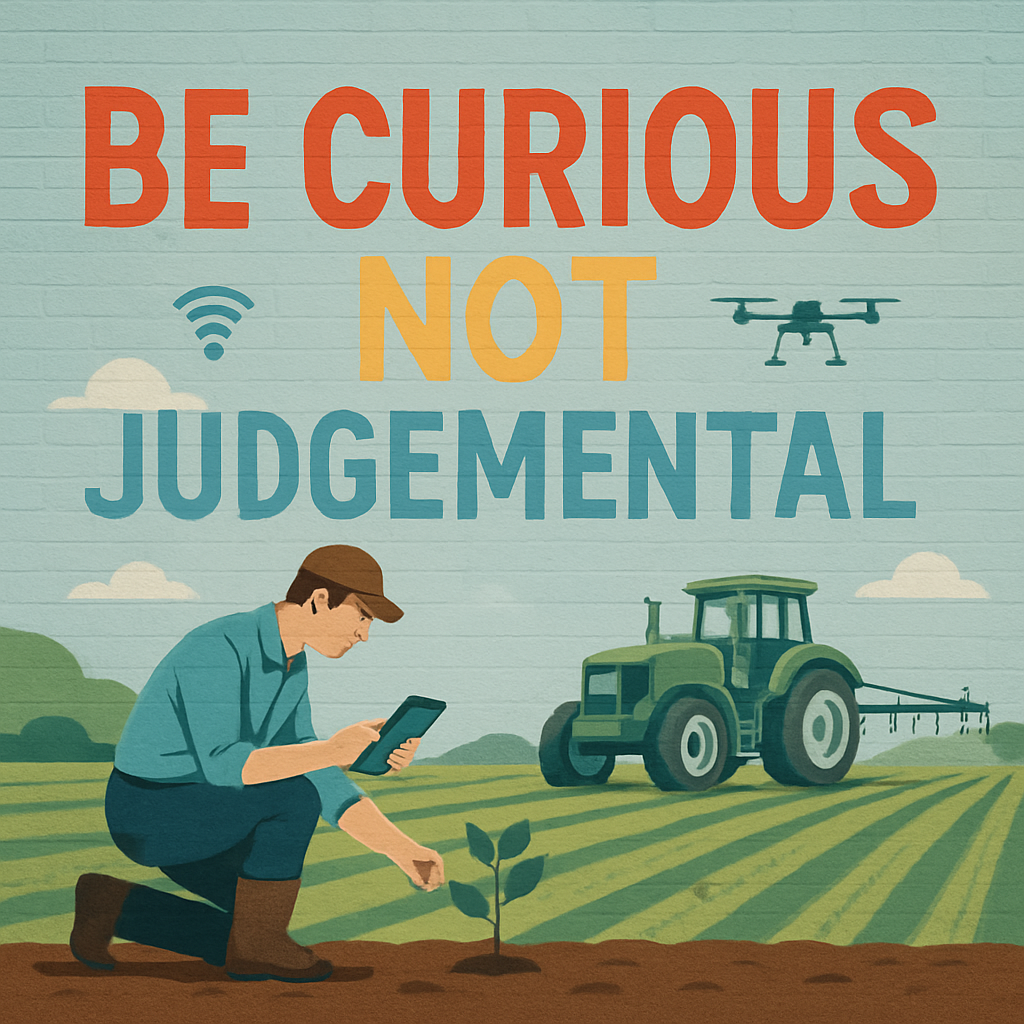Be curious, Not Judgemental
“We all know farmers don’t like to pay for things.”
It was a passing comment, dropped casually during a conversation with a startup founder working on software for the ag sector. I don’t think it was meant with any malice, just one of those throwaway lines you hear too often when people talk about commercialising agtech.
But it stuck with me, and my response was short and to the point:
“Farmers pay for things they see value in.”
The founder nodded and moved on but I kept thinking about it — not because I was offended, but because it reminded me of a broader pattern. Too often, new products in agriculture are built around assumptions, not understanding. In my haste to push back against the stereotype in that conversation I have come to realise I missed an opportunity to explore these assumptions and deepen their understanding of their target market
It’s easy to talk about “the farmer” like they’re a single, average customer segment. Statistically the “average Australian farmer” is still a white male in his late 50s, often running a mixed broadacre operation. That picture is true on paper but there is a deeper understanding needed to understand that the average farmer is just a collection of many different individuals and each of them hold something unique: Personal Identity
How a farmer sees themselves whether it’s as a steward of the land, an innovator, a business manager or a legacy builder. This shapes what they pay attention to, how much risk they’ll carry and what they’re prepared to invest in. Identity ties directly to motivation. If your product or service doesn’t fit a farmer’s sense of who they are or want to be, it doesn’t matter how clever it is it’s unlikely to stick.
So when we treat all farmers the same or rely on a stereotype, we’re not just missing nuance. We’re designing for someone who probably doesn’t exist.
There’s a quote, often attributed to Walt Whitman, I keep coming back to:
“Be curious, not judgmental.”
It’s more than a nice sentiment, it’s an excellent life motto and its vital advice for anyone trying to build for agriculture.
Startups often enter the sector with real passion and clever ideas. But passion alone isn’t enough it needs to be paired with humility and curiosity. Instead of assuming what farmers want or worse, assuming they’re all the same it’s far more effective to ask questions, spend time on-farm, and listen for what’s actually driving decisions.
To touch on the example of pricing. I’ve met startups with great products, things that really solve a problem, but they roll out pricing models that quietly push farmers away. Shared-savings or revenue-percentage models might look smart from the developer’s perspective: “You only pay if you win.” but for farmers, that kind of uncertainty can feel worse than paying upfront.
Farming already comes with enough variables: weather, markets, yields, input costs. Adding another unknown — “What will this actually cost me?” — adds another unknown to the mix.
Think about it like this: imagine if every time you ordered a pint of beer, the price depended on the weight of the glass. The Publican could explain it might be “fairer” as you’d be paying for exactly what you get but that extra layer of complexity would leave many people feeling suspicious and considering why they don’t head down the street to place where they feel more comfortable with the prices.
Coffee’s the same. No one wants to be told their flat white costs more today because the beans were denser or the barista was heavy handed with the milk. People don’t mind paying for value, they mind paying for surprises.
It’s the same for farmers. If a product’s value is clear and the cost feels fair and predictable, most are happy to pay. But if the pricing is a moving target, it becomes a trust issue, not a tight-fistedness issue.
When that happens, it’s tempting for founders to fall back on old lines:
“Farmers just don’t want to pay.”
“Farmers don’t get it.”
But that’s judgment, not curiosity. The real answer might be as simple as: the pricing model makes sense on paper but doesn’t fit how real farm businesses manage risk. If you’re curious enough to dig for that, you can adapt. Sometimes the fix isn’t reinventing the product, it’s removing an invisible barrier you didn’t even know was there.
Curiosity keeps you learning. Judgment shuts you down and this is important to remember for both founders and farmers alike
When something doesn’t land the way you expect or when adoption is slow, feedback is mixed, or pricing causes friction it’s tempting to lean on old assumptions: “Farmers don’t like to pay for things.” or “They’re too set in their ways.”
But assumptions are just shortcuts to avoid the harder work of asking why.
Maybe your product feels like buying a pint when the price changes every pour. No one likes surprise costs and if you take the time to really understand what feels risky or unclear on their side of the fence, you can adapt. That’s what turns good ideas into solutions people actually adopt.
The path to meaningful innovation in agriculture won’t be built on assumptions or on “average farmers” that don’t exist. It will be built on real, grounded understanding: earned by asking better questions, spending time with the people you want to serve, and staying open when the answers challenge your assumptions.
Curiosity invites learning while Judgment cuts it off and, in an industry as complex and varied as farming, staying curious is one of the most valuable tools we’ve got.




